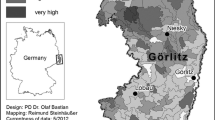You have full access to this open access chapter, Download chapter PDF
Similar content being viewed by others
Correction to: C. von Haaren et al. (eds.), Landscape Planning with Ecosystem Services, Landscape Series 24, https://doi.org/10.1007/978-94-024-1681-7
Fig. 3.3 in Chapter 3 and Fig. 30.1 in Chapter 30 were initially published with errors. The correct presentation is given here.
Defining the decision space of landscape planning. Tasks on different planning tiers are determined by the scale of the problem and associated responsibilities. Projects with cross-boundary impacts or trans-boundary ecosystems (such as river catchments) need to be considered at higher planning tiers with authority that covers the whole relevant area (von Haaren 2016: 171, amended)
A schematic classification of framing conditions for environmental planning in five example countries. The conditions may be decisive for the importance of economic evaluations, the binding character of objectives, the scope and role of public participation and the scale and delineation of the scope of planning. We are aware of the internal differentiation in the USA, where the preconditions may differ a lot among the states. Nevertheless there are some general frame conditions shared by all US states based on the US legal system and on federal policies
Author information
Authors and Affiliations
Editor information
Editors and Affiliations
Rights and permissions
Copyright information
© 2019 Springer Nature B.V.
About this chapter
Cite this chapter
von Haaren, C., Lovett, A.A., Albert, C. (2019). Correction to: Landscape Planning with Ecosystem Services. In: von Haaren, C., Lovett, A., Albert, C. (eds) Landscape Planning with Ecosystem Services. Landscape Series, vol 24. Springer, Dordrecht. https://doi.org/10.1007/978-94-024-1681-7_32
Download citation
DOI: https://doi.org/10.1007/978-94-024-1681-7_32
Published:
Publisher Name: Springer, Dordrecht
Print ISBN: 978-94-024-1679-4
Online ISBN: 978-94-024-1681-7
eBook Packages: Biomedical and Life SciencesBiomedical and Life Sciences (R0)






